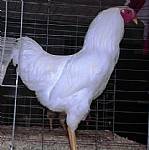
Chantecler cockerel
Chantecler Chickens
I am currently raising a few chickens. We are concentrating on dual purpose birds, wanting to produce our own eggs as well as meat. To this extent we have selected the Chantecler breed (the only Canadian made chicken breed). Our chickens are fed a natural diet as well as grass, weeds and whatever else they can find in their enclosure. Being new to this from a breeding standpoint, we are still learning some things involving selection criteria. Ultimately we are trying to produce true to breed characteristic chickens that are excellent for farm flock production. To this end we have selected birds from a number of Quebec and Ontario flocks as well as getting genetics from Western Canadian breeders. To further develop our breeding program and show this wonderful breed to the public, I have joined with Liz Munro to create the Chantecler Syndicate. This joint venture will allow an increase in our genetic lines and I know Liz will do a great job in showing our birds and giving advice to new breeders. We will both run breeding flocks with multiple lines, with Liz showing and myself, Patric Lyster, concentrating on the marketing of our joint production. Please do not hesitate to contact us for your Chantecler needs or advice.
Breeding stock usually available. Breed information follows and check sales pages or bottom of page for specific sales.
CHANTECLER CHICKEN
| Origin |
Quebec, Canada |
| Distribution |
Canada (principally Quebec and Ontario), USA |
| Status |
Rare |

HISTORY
The Chantecler chicken is a composite breed, derived from the following: Dark Cornish, White Leghorn, Rhode Island Red, White Wyandotte, Columbian Wyandotte and White Plymouth Rock.
Brother Wilfrid was the poultryman in charge of the flocks at the Cistercian Trappist Monastery at Oka, Quebec, a small community located west of Montreal on the north shore of the Ottawa River. He realized that there were no birds of Canadian origin at Oka and decided to breed a truly Canadian fowl (Wilfrid, 1922). This task took 9 years to complete.
Brother Wilfrid wrote a letter in 1941 explaining how he chose the name Chantecler. The name was taken from a hero in the French poet Rostand’s fable. popular in Paris about 1910, about the love between the rooster Chantecler and a golden pheasant hen. He thought that the name, derived from two French words, “chanter” – “to sing” and “clair” – “bright”, was ideal for his new breed.
G.Toupin (1922) wrote the actual description of how the breed was developed, while still a student at Oka Agricultural Institute. He was a professor when the breed was eventually shown to the world.
In 1908, Brother Wilfrid was in charge of the poultry yards at Oka and when his father visited him they both realized that all the breeds at Oka were either European or from U.S.A. Brother Wilfrid decided that he had to do something about this situation and devoted many hours to planning how he could develop a breed that was unique to Canada.
He decided that the breed should be dual purpose, white, and a good winter layer; above all, the comb and wattles should be relatively frost resistant. He studied all the breeds available at Oka and decided that the first breed to be used should be the Cornish because of its small comb and wattles. To improve egg production he bred the Cornish Male to a White Leghorn female. The progeny of this cross were of a gray colour but with no meat qualities. The second cross in the first year was to mate a Rhode Island Red male to a White Wyandotte female. This resulted in white progeny with black spots. There was however one beautiful male which had true Columbian Wyandotte colouring.
Knowing that the female transmits the feather colour and the male the conformation, Brother Wilfrid decided to mate this male with the best-coloured females from the first cross. The progeny was off white in colour and the majority had the characteristics of the Cornish. Unfortunately egg production was poor and the colouring was not standardized.
Brother Wilfrid decided that he had to make major changes and decided to use a large White Plymouth Rock male on the best pullets. Even at this stage he was not happy with conformation or production and resorted to the true tool of any dedicated breeder, culling.
By 1913 this aggressive culling had improved the progeny so he divided these birds into 2 flocks. In one of them he decided to conduct inbreeding and in the other half he decided to use a good White Wyandotte male.
By 1916 he thought he was close to the breed he had in mind except for body weight. Among the spring 1916 progeny there was one large pullet that weighed 3.5kg. (This is 1kg heavier than today's Standard for the breed.) Despite its size this bird produced 90 eggs in 120 days. This is 75% production in the early 1900s probably in buildings with no insulation.
At this stage he decided to risk breeding this pullet to a large White Plymouth Rock male weighing 4.55kg (This is also heavier than the accepted Standard of 3.8kg for The White Plymouth Rock). These risks were justified and the progeny were excellent.
In 1918 the best males from the heavy male and heavy female matings were bred to the best hens from the originally divided lines of 1913.
Obviously using the heavy lines would result in progeny with single combs, as the genes would be there from the White Plymouth Rock. Again, extensive culling was practiced and single combs were eliminated. Even today (2003) one or two single combs will show up in some matings and these have to be culled. At this stage Brother Wilfrid decided that the Chantecler could be declared a new breed for Canada (Taupin, 1922)
An association, started in 1918, adopted strict rules to control breeding and ownership. A member could not sell, lease, lend, give or exchange any living bird of the new breed nor sell hatching eggs to anyone who was not a member of the association. It was also a requirement that the Association be given a full list of birds owned by members. This might not be a bad idea today especially with rare breeds of poultry.
The White Chantecler gained a lot of publicity at The First Canadian National poultry Conference in 1919 and was officially declared a breed in 1921.
Appearance
The body is long and deep and should slope towards the tail. The small cushion comb is attached toward the front of the head and is seated along the head among the feathers. The wattles are very small and tucked close to the neck. The head is broad (from the Cornish origin). The beak is curved and has a strong appearance because it is short as in most Cornish types. The breast is wide and deep.
Brother Wilfrid wanted a good winter layer with small combs and wattles to minimize frost bite in winter. The comb is classified as a cushion comb and fits close to the curve of the head. The back must be broad and long a blend into the tail which should be at thirty degrees to the horizontal. The breast should be deep and well fleshed. The skin is yellow and the legs are set wide apart and with strong bones.
Colour
Pure white with yellow skin. The only other colour other than the white is the Partridge that was developed in Alberta, and accepted as a breed in 1935.
Size
The Standards call for the males to weigh between 3.4kg to 3.9kg depending on age, and the female to weigh between 2.5kg and 3kg depending on age. (American Standards of Perfection, 1985).
Reproductive traits
A good strain will lay up to 210 eggs per bird in 1 year's lay and the eggs should weigh about 58 to 60 grams. The egg colour is a light brown
Hardiness
Small combs and wattles minimize frostbite in winter.
Uses
Dual purpose meaning the breed was intended to produce a reasonable number of eggs and have carcass value at the and of it's productive life
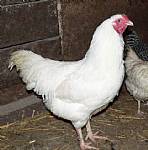 Chantecler rooster
Chantecler rooster
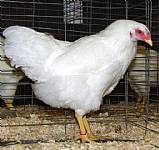 Chantecler pullet-Champion Wetaskiwin 2010
Chantecler pullet-Champion Wetaskiwin 2010
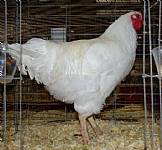 1st place rooster Wetaskiwin 2010
1st place rooster Wetaskiwin 2010
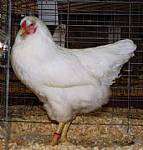 1st Chantecler hen 2010 Wetaskiwin show
1st Chantecler hen 2010 Wetaskiwin show
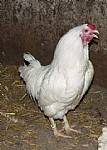 Chantecler rooster
Chantecler rooster



